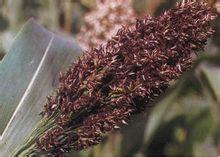Sorghum anthracnose

Symptom the disease is an important disease of sorghum, which occurs in all producing areas of sorghum. The disease can be infected from seedling stage to adult stage. Infection at seedling stage is harmful to leaves, resulting in withered leaves and death of sorghum seedlings. The disease spot of the leaf is fusiform, the middle is reddish brown, the edge is purplish red, and there are dense small black spots on the disease spot, that is, the pathogen conidium disk. Anthracnose mostly occurs from the top of the leaf, the size of 2 Mel 4 × 1 Mel 2 (mm), seriously causing local or most of the leaves to die. The disease spot of leaf sheath is large, oval, and there are also small black spots in the later stage. After heading of sorghum, the pathogen can also infect the young neck of the ear, the injured part forms a larger disease spot, and there are also small black spots on it, which is easy to cause the diseased ear to turn back. In addition, it can also damage the ear axis and branches or stems, resulting in corruption. Pathogen Colletotrichum graminicola (Cesati) Wilson. It is called Colletotrichum graminearum, which belongs to the subphylum of semiknowns. Conidium disk black, scattered or aggregated on both sides of the spot, 30-200um in diameter. Setae straight or slightly curved mixed, brown or black, tip pointed, with 7 diaphragms of 3muri, size 64C128x4Mu6 (um), scattered or arranged in rows in the conidium disk. The single cell of conidiophores is colorless, cylindrical, and the size is 10mur14 × 4Mel 5 (um). The conidia are falcate or fusiform, slightly curved, colorless, and the size of the conidia is 17mur32 × 3mur5 (um). In addition to harming sorghum, it can also harm wheat, oats, corn and other Gramineae plants. The pathogens of transmission and disease conditions overwintered with seeds or diseased bodies. After the disease occurred in the field in the following year, the disease in the seedling stage could lead to the death of seedlings. A large number of conidia are produced on the disease spot in the adult stage, which spread by airflow and re-infect for many times, which spreads and spreads continuously or causes epidemic. There were significant differences in disease among sorghum varieties. Rainy years or low-lying and high-wet fields are common, resulting in early drying and death of leaves. The occurrence of anthracnose in northern sorghum producing areas was early, and the low temperature and high rainfall from July to August could lead to the early death of sorghum. Control methods (1) deal with the residual body in time after harvest, turn the residual body deeply into the deep soil, in order to reduce the source of primary infection. (2) implement large area rotation, apply fully mature organic fertilizer, adopt sorghum formula fertilization technology, topdressing ammonium nitrate during the third intertillage and weeding, so as not to remove fertilizer in the later stage and enhance disease resistance. (3) selecting and popularizing local resistant varieties and eliminating susceptible varieties. (4) seed treatment with 50% thiram powder of 0.5% seed weight or 50% seed dressing powder or 50% carbendazim wettable powder can prevent anthracnose and northern anthracnose transmitted by seeds at seedling stage. (5) from booting stage, 36% thiophanate methyl suspension or 50% carbendazim wettable powder, 1500 carbendazim wettable powder, 25% carbendazim wettable powder and 80% carbendazim 45 wettable powder were sprayed in epidemic years or individual susceptible fields.
- Prev

Sorghum sheath blight
Symptoms of this disease are common in northern China and Taiwan, hybrid sorghum is more serious, and it also occurs in central China and southwest China. It mainly damages leaf sheaths and leaves. After the disease, water-soaked lesions were produced on the stems near the ground, and purple-red and gray-white spots were produced on the posterior leaf sheaths. In late growth or rainy and humid weather...
- Next

Occurrence and control of head smut in sorghum
Due to the continuous expansion of sorghum planting area and the extension of planting years, the harm of head smut of sorghum is becoming more and more serious, which directly affects the production and development of sorghum. First, the damage degree of sorghum head smut only occurred sporadically in the local area of the county in the early 1990 s, and the area of sorghum head smut in individual villages and towns was about 43 m in 2000.
Related
- The first cup of black tea in spring, the flavor and history of tea gardens in Kenya, Africa
- The computer can not only choose potatoes, but also grow tea rice. AI will grow winter oolong tea champion.
- It is not only the inflated tea bitten by insects, but also engraved with the four seasons tea in Beipu.
- The Oriental Beauty Tea Festival in Zhuxian County takes the stage at the weekend to experience the plus-size feast of oil tea.
- & quot; Oriental Beauty Tea & Exploration of Emei in Hsinchu, the hometown of quot;
- The new variety of strawberry "Tainong 1" dessert is the first choice with mellow aroma. Crimson gorgeous
- History of Tea in Taiwan: from Wild Inner Mountain to Export Tea Garden
- Two types of Taiwan Oriental Beauty Black Tea won the British three-Star Award for Childhood Tea Xiang Zhang Jiaqi changed from pilot to champion tea maker.
- Banana species and varieties: the planting history of Taiwan Xianren banana and dwarf banana is long, is banana disease resistant?
- Coffee planting Technology: Qianjie Coffee from Seedling to harvesting

